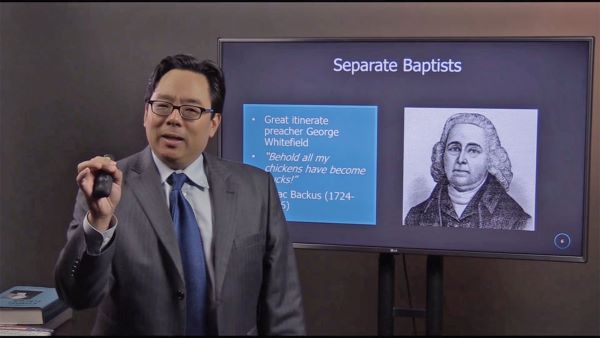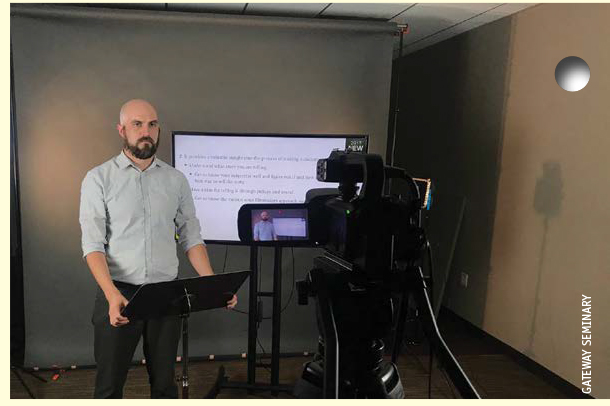
The mission of Gateway Seminary’s online campus is not very different from that of other seminaries with online offerings: “Gateway Online exists to shape leaders who expand God’s kingdom around the world by making theological education available to students anywhere in the world.” However, the seminary has instituted a particularly thoroughgoing approach to faculty buy-in and training for online education.
In the mid-1990s, Gateway (then named Golden Gate Baptist Theological Seminary), like a few other institutions, first dipped its toes into online waters. In 2001, Golden Gate was among the early schools granted permission by the Association of Theological Schools (ATS) to offer online versions of some courses required for accredited degrees. But it was not until 2006 that the school began ramping up its online course offerings, says Kristen Ferguson, Gateway’s director of online education. The seminary contracted with Learning House to make better use of the Moodle course learning management system (LMS) they were using and to improve the design of its courses.
In 2013, when ATS first permitted schools to offer a fully online M.Div., Golden Gate was one of six schools given exemption from residency requirements for M.Div. and professional M.A. degrees. (The others were Anderson University School of Theology, Chicago Theological Seminary, Pentecostal Theological Seminary, Southeastern Baptist Theological Seminary, and Southwestern Baptist Theological Seminary.) In a press release at the time, Mike Martin, vice president of academic affairs at Golden Gate, wrote: “We have extensive experience doing effective ministry training using the tool of online education. Our first online class was offered in 1998, and our commitment is always to provide a high-quality education with the maximum student-to-professor and peer-to-peer interaction.”
Although Golden Gate encouraged full-time faculty to teach online classes, seminary leaders recognized that not all faculty members were comfortable with this method of teaching and at first did not make online teaching a requirement for faculty. But since 2014, all full-time professors have been required to teach online as part of their contracts. Today, 70 to 80 percent of all courses, including those offered on campus, have an online component. The M.Div., M.T.S., M.A. in intercultural studies, and M.A. in educational leadership can all be taken completely online. The M.A. in Christian counseling and the M.A. in missiology have both been approved by ATS and will be fully online starting this fall.
In 2016, Golden Gate relocated its main campus from northern to southern California and changed its name to Gateway. The plan from the outset was to make the new campus a commuter campus, with a corporate feel and the technology for all kinds of remote and online access. Ferguson says that having a traditional class schedule — Monday through Friday and during daytime hours — does not fit into the seminary’s goals for the new campus or the demographic it serves. To accommodate working adults with full-time jobs, many courses are offered just once a week, either on Saturday or on a weeknight. “We have worked really hard to make a flexible schedule with a lot of hybrid courses,” she adds.
The seminary eventually switched from the Moodle LMS to Canvas. Ferguson reports that Canvas allows administrators to control the course content and offers faculty more ownership of their content. All Gateway faculty members, even those not currently teaching online classes, enroll in Canvas’s “faculty center” where there is extensive support, training and best practices for every possible component of the program — from the administration, documentation, tracking, reporting, and delivery of its courses, to how to use tools like Turnitin and Zoom. Although Ferguson says that while switching from Moodle to Canvas was a big transition for the seminary, there have been few technical problems.
At Gateway, online teaching is now a regular part of the faculty load, not an additional overload. Faculty are paid above and beyond their regular salary to develop online courses, although they do not get course release time. Developing courses is part of a faculty member’s tenure evaluation portfolio and is considered a positive.
In 2017, Gateway was awarded an ATS innovation grant for a proposal titled “A Faculty-Centered Model of Instructional Design for an Age of Blended Delivery Systems.” The grant provided the seminary with hardware, software, and training for faculty to improve the consistency and quality of online, hybrid, and remote-access classes.
The grant-funded activities included opening the Gateway video studio to all faculty and providing them with video editing software. Furthermore, a team of faculty and staff researched online pedagogy and created a best practices document on blended learning for all faculty to follow, which is excerpted below. Also, 10 faculty members pursued an Online Consortium Learning Certificate and led a webinar on best practices for their fellow faculty, which resulted in revisions to the best practices document.
Today, all required classes — online, hybrid, extension campus, or in-person — follow a faculty-designed template for basic components like course descriptions, objectives, and signature assignments, but the classes can be modified to best suit different delivery formats.
An excerpt from Gateway Seminary’s “Best Practices for Blended Learning”
Gateway Seminary provides clear instructions and expectations for faculty who teach in a blended learning environment.To enhance student learning, the seminary distributes a document called “Best Practices for Blended Learning” to all faculty.
Introduction
At Gateway Seminary, blended learning includes remote access and hybrid courses. The practices below reflect faculty collaboration and research in an effort to maintain a high standard of instruction in online education and traditional face-to-face education.
General
- Calculation of hours of coursework should be a combination of all on-campus and online components.
- Clear information about the division of coursework between on-campus and online should be communicated to students.
- Information about accessing the online course components should be present in the course syllabus.
- All course content should follow copyright and fair use law.
- All online components should be both professional-looking and well organized but maintain the professor’s own personality and character.
- Instructors are encouraged to share their pedagogical plans and practices with their fellow faculty — both what is working and what is not working — for the benefit of educational effectiveness.

Chris Chun recording a fully online course on the theology and legacy of Jonathan Edwards. Chun is chair of history and theological studies at Gateway and director of the seminary’s Jonathan Edwards Center.
Courtesy Gateway Seminary
Online Components
- Online components should be organized into modules for quick reference and clear structure. (A module is a grouping of assignments, content, or information according to week or unit of study.)
- All online components of any delivery system should include clear instructions for finding, completing, and submitting the required elements for the course.
- Timely feedback on online assignments and discussions is highly recommended to encourage student participation, development, and formation. Student perception of the sustained presence of the instructor in the course has a direct impact on student learning.
Discussions
- Clear expectations on substance, length, and frequency of posts should be communicated to students.
- Discussion prompts should not be merely objective in nature but provide material in which students can critically engage one another and the content.
Quizzes
- To promote integrity in students, professors should take into account the nature of online education when requiring a quiz (e.g. open-book with time limit, or using a proctor with supplied contact information for verification).
Group Work
- For blended courses, providing time on campus for groups to begin work is recommended for fostering community and success in online group work.
Online Community and Spiritual Formation
- Professors should respond to student inquiries (email, phone, or other means) within 24–48 hours to foster community and promptly address student questions and concerns.
- Professors should provide regular updates or announcements during online components of the course to maintain community and student engagement.
- Professors should foster an online learning community by providing opportunities for students to interact with one another, with course content, and with the instructor.
- Professors should provide opportunities for students to reflect on their own growth as a result of contact with course content, peer interaction, and professor interaction.
- Professors should provide substantive and engaging feedback to encourage formation.
Remote Access
Technology
- Details about the software and hardware requirements should be communicated in the syllabus.
- A pre-semester test of video conference software with students is recommended.
- Students should be required to use headphones with a microphone for quality audio and elimination of feedback and echoes.
- Instructors should communicate an alternate form of contact (email or phone) that remote access students can utilize should they experience technical difficulties.
- It is recommended that remote access class times should be recorded and posted on the course LMS.
- Lapel microphones should be worn by the professor during the lecture.
- Classroom microphones should be on when class discussion is happening.
- It is recommended that instructors use a tablet for digital whiteboard capabilities, as needed.
Pedagogy
- Professors should maximize synchronous participation with remote access students during class sessions, but an asynchronous online discussion should be also made available to remote access students for questions or comments about the synchronous class time.
- Professors should provide clear directions and expectations for completing coursework remotely.
- Pedagogy should be designed to optimize the experience of face-to-face and remote students. This may require a variation or replacement of the in-class pedagogy for remote students.
- Professors should use the course LMS for remote student assignment submissions, class handouts, further resources, discussions, etc.
- While learning objectives will not change, assessments for remote access students should take into consideration their distance and use of the video conferencing software.
- Professors are encouraged to facilitate active learning strategies both online and face-to-face to allow students the opportunity to practice implementing and applying course content.

Tyler Sander, director of communications at Gateway Seminary, preparing the seminary’s video studio for the next class.
Video Creation
General
- All video content should consistently maintain a high-quality image, i.e., no pixelation, blur, angle distortion, distracting exposure, or anything that can detract from the educational purpose of the video. (Note: Students state that videos can detract from learning if they are poor audio or video quality.)
- Proper permissions should be acquired to use video content in a course.
- Video content should be reviewed thoroughly to ensure it is edifying for seminary students.
- It is recommended that videos be no longer than 20 minutes each.
- Students prefer quality images, graphs, and other visual elements that pertain to the content and are not extraneous, therefore, it is recommended that professors include additional media only as needed.
- Comprehension of content within videos should be assessed within the course curriculum by means such as discussion, quizzes, and written assignments.
Excerpted and used with permission. The full document, “Best Practices for Blended Learning,” is available online at bit.ly/Gateway-Blended.